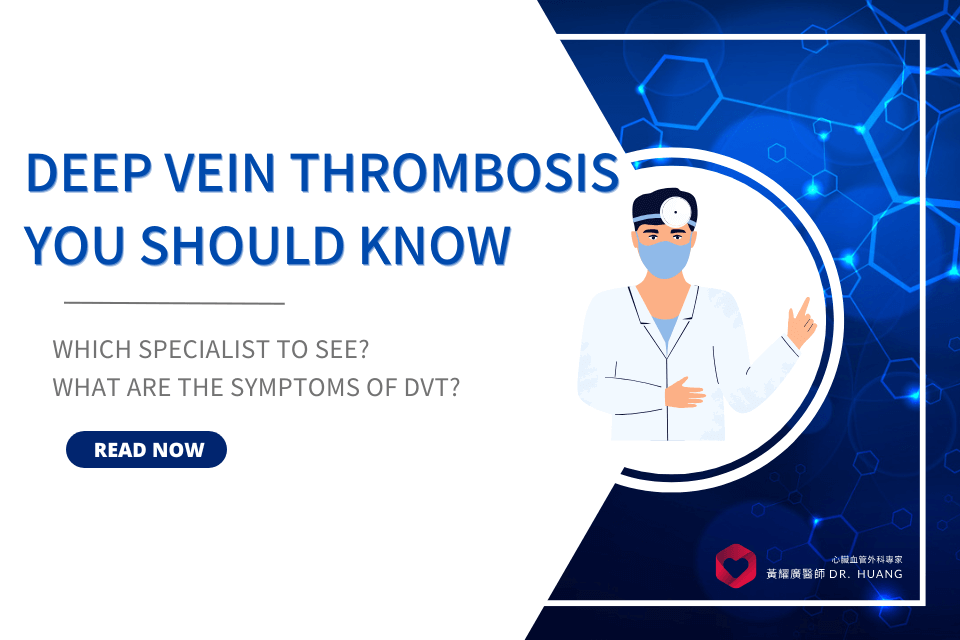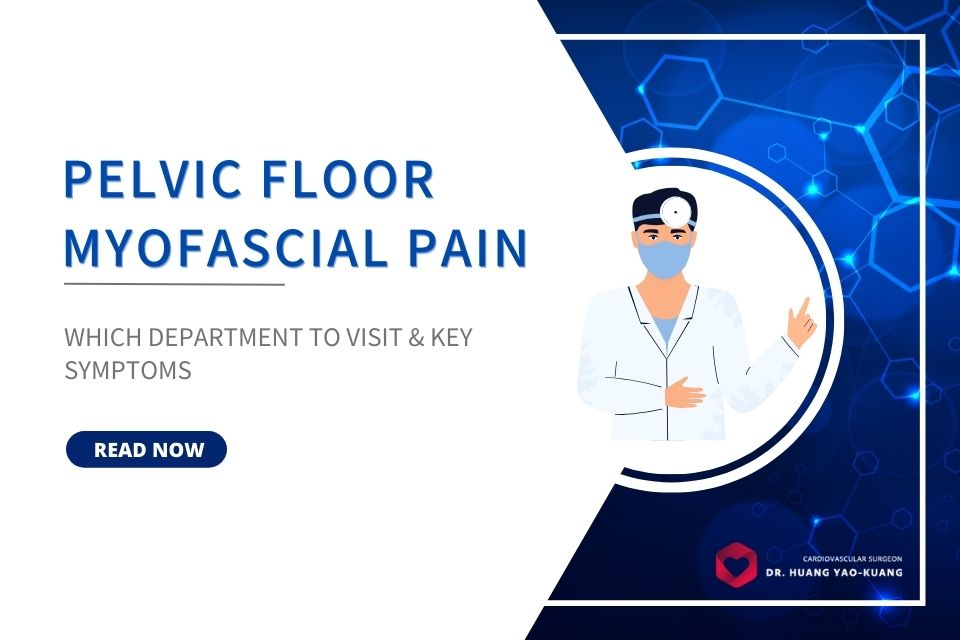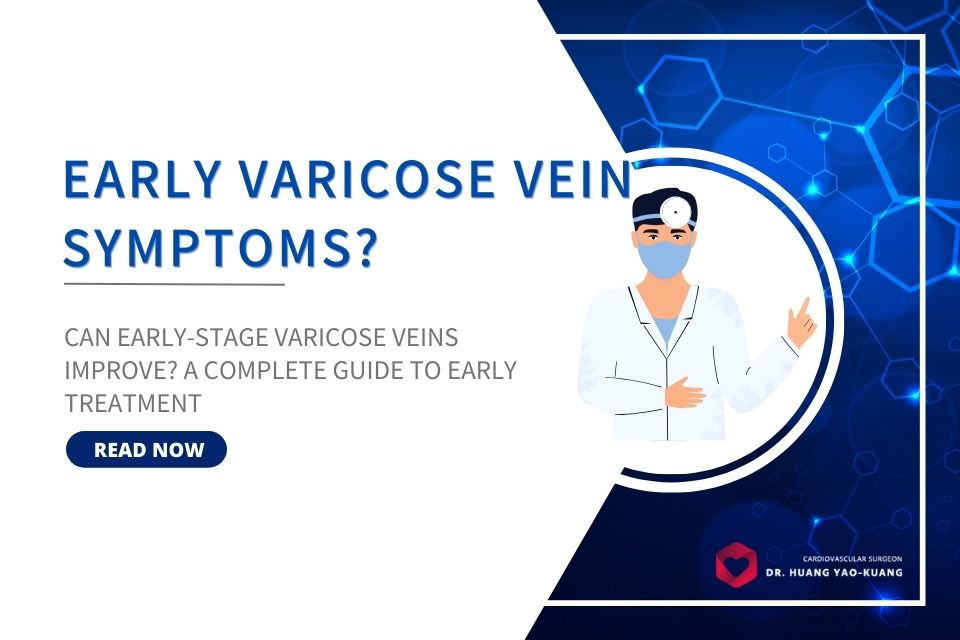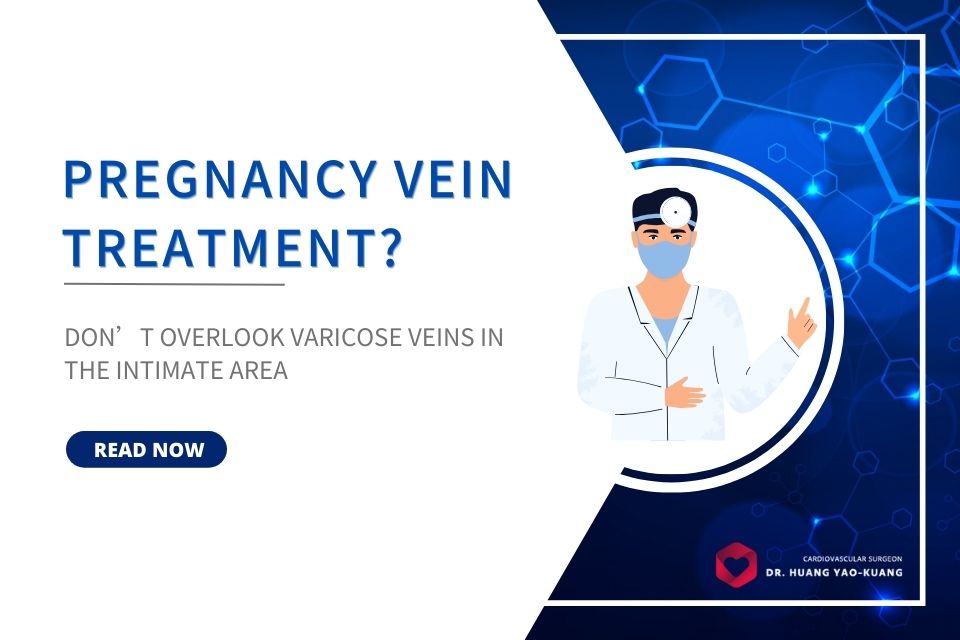
Leg DVT: Which Specialist to See? Symptoms, Causes, and Treatments You Should Know
Leg DVT: Which Specialist to See? Symptoms, Causes, and Treatments You Should Know
Deep vein thrombosis (DVT) in the legs refers to the formation of blood clots in the deep veins of the lower limbs, which can obstruct normal blood circulation.
Common symptoms include swelling in one leg, pain, warmth, and skin discoloration. If left untreated, part of the clot may break off and travel to the lungs, leading to pulmonary embolism, a potentially life-threatening condition.
If you notice any of these symptoms, it's important to seek medical attention immediately. Depending on the severity, doctors may prescribe anticoagulants, thrombolytic therapy, or even perform surgical intervention.
But did you know? In addition to medical treatment, lifestyle adjustments and prevention strategies are essential.
In the following sections, Dr. Huang will guide you through the causes, risk factors, and preventive measures that can help reduce your chances of developing DVT.
Quick Overview of Leg DVT
What Is Deep Vein Thrombosis (DVT) in the Legs?
Deep vein thrombosis (DVT) is a condition in which a blood clot forms in the deep veins of the leg, leading to poor blood return to the heart.
It most commonly occurs in the calf, popliteal vein, or femoral vein, and can cause symptoms such as swelling, pain, and redness in the affected limb.
Causes of Deep Vein Thrombosis (DVT) in the Legs
- Slow blood flow: Prolonged sitting or bed rest can slow circulation, increasing the risk of clot formation.
- Vessel wall injury: Surgery, trauma, or other factors may damage the inner lining of veins, making clotting more likely.
- Abnormal blood clotting: Certain medical conditions (such as cancer or heart disease) and hormonal treatments (such as oral contraceptives) can increase blood coagulability.
About 1 in 10 patients diagnosed with a first-time DVT may have an undiagnosed cancer, so it’s essential to thoroughly investigate the underlying cause.
Complications of Deep Vein Thrombosis (DVT)
- Pulmonary Embolism (PE): If a clot breaks free and travels to the lungs, it can block a pulmonary artery, potentially causing shortness of breath or sudden death.
- Chronic Venous Insufficiency: Damage to the vein valves from the clot can lead to persistent leg swelling, heaviness, and varicose veins.
- Limb Ischemia: In severe cases, DVT can restrict blood flow to the tissues, causing chronic wounds, tissue necrosis, and even amputation.
High-Risk Groups for Deep Vein Thrombosis
- Prolonged bed rest or limited mobility: Such as post-surgical patients, individuals on long-term bed rest, or those with paralysis.
- Extended sitting: Long-distance travelers, office workers, or anyone who remains seated for extended periods.
- Pregnant women: Pregnancy increases blood coagulability, and the growing uterus may compress the inferior vena cava, slowing blood flow from the legs.
- Those taking oral contraceptives or hormone replacement therapy (HRT): These medications can increase the risk of blood clotting.
- People with underlying health conditions: Including cancer, heart disease, or chronic obstructive pulmonary disease (COPD)—all of which elevate thrombosis risk.
- Individuals with a history of DVT: Those who have previously experienced DVT are at higher risk of recurrence.
Get Expert Cardiovascular Advice Now
Expert Surgeons for Comprehensive Cardiovascular Treatment!
Instant Online Consultation Available
Which Specialist Should You See for Leg Vein Thrombosis?
Deep vein thrombosis (DVT) in the legs is a common vascular condition. If you start experiencing related symptoms, you might wonder:
Should I see a cardiologist or a vascular surgeon?
While both specialties deal with blood vessel diseases, their focus areas differ.
Cardiology
If you're experiencing systemic symptoms such as shortness of breath or chest pain, or if there is a concern that the clot may have traveled to the lungs (causing a pulmonary embolism), it is best to consult a cardiologist.
These specialists are trained to handle cardiovascular emergencies and can perform urgent diagnostic and therapeutic procedures.
Vascular Surgery
If your symptoms are localized, such as leg swelling, pain, or heaviness, and you do not have breathing difficulties, you may consider visiting a vascular surgeon, who specializes in diseases of the arteries and veins in the limbs.
Regardless of which specialist you choose, the most important thing is to clearly describe your symptoms during the consultation—including the location and intensity of the pain, the degree of swelling, whether you have a fever, and any other concerns.
This helps your doctor make a more accurate diagnosis and provide timely treatment.
Get Expert Cardiovascular Advice Now
Expert Surgeons for Comprehensive Cardiovascular Treatment!
Instant Online Consultation Available
What Are the Symptoms of Deep Vein Thrombosis in the Legs?
The symptoms of leg DVT can range from mild to life-threatening, depending on the severity of the condition. Common symptoms include:
1.Leg Swelling (Mild)
Blood flow is obstructed, causing noticeable swelling in one leg—usually starting from the calf—often accompanied by heaviness or discomfort.
2.Pain or Tenderness (Moderate)
A dull ache or soreness in the calf or thigh, which may worsen with standing, walking, or pressure on the area.
3.Skin Changes (Moderate to Severe)
The affected area may show redness or a purplish tint, warmth to the touch, swelling along the vein, or visible surface veins.
4.Limited Leg Function (Severe)
In more advanced cases, patients may have trouble walking or bearing weight due to intense pain, indicating that the clot is severely blocking deep venous return. Immediate medical attention is required.
5.Acute Complications (Critical)
If a clot breaks off and travels to the lungs, it can cause a pulmonary embolism, leading to shortness of breath, chest pain, heart palpitations, sudden fainting, or even shock. This is a medical emergency.
If you experience any of the above symptoms, seek medical care immediately to prevent complications or worsening of the condition.
Treatment Options for Deep Vein Thrombosis (DVT) in the Legs
If you notice symptoms such as unilateral leg swelling, pain, or warmth, especially after prolonged sitting or bed rest, seek medical attention promptly.
The earlier DVT is diagnosed and treated, the lower the risk of serious complications.
The main goals of treatment are to prevent clot progression, dissolve existing clots, and restore proper blood flow. Common treatment options include:
1. Anticoagulants
Medications that prevent further clot formation and stop existing clots from growing.
- Who it's for: Most DVT patients, especially those at high risk of recurrence.
- Effectiveness: Significantly reduces symptoms and the risk of pulmonary embolism.
2. Thrombolytic Therapy
Medications used to actively dissolve blood clots and restore venous flow.
- Who it's for: Acute DVT cases with severe symptoms or high risk of pulmonary embolism.
- Effectiveness: Can quickly reduce clot burden, but carries a higher risk of bleeding and must be used with caution.
3. Medical-Grade Compression Stockings
External pressure garments that improve blood return and reduce pooling.
- Who it's for: All DVT patients, especially those who are bedridden or sedentary.
- Effectiveness: Helps relieve leg swelling and discomfort, and prevents recurrence.
4. Inferior Vena Cava (IVC) Filter
A small device placed in the inferior vena cava to catch clots before they reach the lungs.
- Who it's for: Patients who cannot take anticoagulants or for whom anticoagulants have failed.
- Effectiveness: Reduces the risk of pulmonary embolism but does not treat existing clots.
5. Surgical Thrombectomy
A procedure to physically remove the blood clot and restore venous circulation.
- Who it's for: Severe cases, especially when the affected limb shows signs of ischemia or pulmonary embolism risk is extremely high.
- Effectiveness: Rapid relief of obstruction, but carries surgical risks.
6. Venous Stenting
Placement of a stent inside the vein to keep it open and prevent narrowing or collapse.
- Who it's for: Patients with vein narrowing or obstruction, especially when symptoms persist despite anticoagulation.
- Effectiveness: Improves venous return, though there is a risk of stent migration or blockage.
7. Bed Rest and Leg Elevation
Reducing activity and elevating the affected leg to ease swelling and promote blood flow.
- Who it's for: Recommended for all DVT patients during the acute phase.
- Effectiveness: Helps relieve symptoms and supports venous recovery.
Get Expert Cardiovascular Advice Now
Expert Surgeons for Comprehensive Cardiovascular Treatment!
Instant Online Consultation Available
How Is Deep Vein Thrombosis (DVT) Diagnosed?
Diagnosing DVT requires a combination of clinical symptoms and imaging studies. Common diagnostic methods include:
1.D-dimer Test
Measures the level of D-dimer, a protein fragment produced when a blood clot dissolves. A positive result may indicate the need for further testing.
2. Color Doppler Ultrasound
A non-invasive imaging technique that evaluates blood flow in the veins and detects the presence and location of clots.
3. Venography
Involves injecting a contrast agent to visualize the vein structure and clearly show the location and extent of the clot.
4. CT Venography
Combines CT scanning with contrast dye to produce detailed images of the veins, helping confirm the presence of a thrombus.
5. Nuclear Medicine Venography
Uses radioactive tracers to assess venous blood flow and detect small or early-stage clots.
6. Venous Pressure Measurement
Evaluates pressure changes inside the veins to assess whether blood flow is obstructed.
DVT Symptom Checklist
The following symptoms can serve as a preliminary checklist for possible leg DVT. If you experience multiple signs, it is recommended to seek medical attention immediately.
- If symptoms are localized to one leg, DVT may be present.
- If you develop systemic symptoms like shortness of breath, chest pain, or palpitations, you should suspect a pulmonary embolism and visit the emergency room without delay.
| Symptom | Present (✓/✗) |
| Noticeable swelling in one leg | |
| Dull ache or tenderness in the leg | |
| Redness, purplish skin tone, or warmth in the affected leg | |
| Feeling of fullness or pressure in the calf or thigh | |
| Sudden shortness of breath, chest pain, or palpitations (PE warning) |
Frequently Asked Questions About DVT
Q1: What is “Economy Class Syndrome”?
Economy Class Syndrome is a colloquial term for Deep Vein Thrombosis (DVT)—a condition where blood clots form in deep veins, most commonly in the legs.
The name comes from the increased risk of DVT during long flights, where sitting still for extended periods can slow circulation and raise the likelihood of clot formation.
Q2: Is surgery always required for deep vein thrombosis in the legs?
Not necessarily. Treatment depends on the patient's condition, the size and location of the clot, and other individual factors.
- Medication: Most cases can be treated with anticoagulants to prevent clot growth and reduce the risk of complications.
- Surgery: May be required for large clots, when medication is ineffective, or when complications arise. Surgical options include thrombectomy or venous stenting.
Q3: Is DVT surgery expensive?
The cost of DVT-related surgery varies based on factors such as the patient’s condition, the type of procedure performed, and the hospital.
For accurate cost information, feel free to consult Dr. Yao-Kuang Huang, Cardiovascular Specialist, through our online consultation service.
Q4: What’s the difference between venous and arterial thrombosis?
Although both involve blood clots, they affect different types of vessels and have distinct symptoms and treatment approaches:
- Venous thrombosis (DVT): Clots form in the veins, blocking blood return to the heart. Common symptoms include swelling and pain in the affected limb.
- Arterial thrombosis: Clots form in the arteries, restricting blood flow to tissues. Symptoms include pain, paleness, coldness, or tissue necrosis in the affected area.
Q5: Can exercise cure venous thrombosis?
Exercise helps promote blood circulation and can reduce the risk of future clots. However, it cannot dissolve existing clots.
If you’ve already developed DVT, physical activity should be performed only under medical supervision, as overexertion may increase the risk of complications.
How to Prevent Deep Vein Thrombosis (DVT) in the Legs?
Preventing leg DVT starts with healthy daily habits. Taking early action can significantly reduce the risk of blood clots. Here are some practical prevention strategies:
- Move regularly: Avoid sitting or standing for long periods. If seated for extended durations (e.g., working or traveling), get up and walk around regularly to improve circulation.
- Do light exercises: Simple leg movements, such as ankle flexes or air cycling, can help promote venous return and prevent stagnation.
- Wear compression stockings: Medical-grade compression socks (usually 20–30 mmHg) provide vein support and reduce the risk of blood pooling in the legs.
- Elevate your legs: While resting, elevate your legs to encourage venous drainage and reduce swelling.
- Maintain a healthy weight: Excess weight can increase pressure on your veins. Managing your weight helps reduce strain on the circulatory system.
- Eat foods rich in natural anticoagulants: Include omega-3 and vitamin E–rich foods like salmon, flaxseeds, nuts, spinach, and sunflower seeds in your diet.
- Stay hydrated: Drink enough water throughout the day to prevent thickened blood and lower the risk of clot formation.
Specialist DVT Care: Dr. Huang, Cardiovascular Surgeon
Dr. Huang specializes in the diagnosis and treatment of venous thrombosis. He provides expert medical guidance and customized treatment plans to help patients manage their condition and reduce the risk of recurrence.
If you have any questions about leg vein thrombosis or need professional care, feel free to book a consultation with Dr. Huang’s cardiovascular surgery clinic.
Get Expert Cardiovascular Advice Now
Expert Surgeons for Comprehensive Cardiovascular Treatment!
Instant Online Consultation Available


